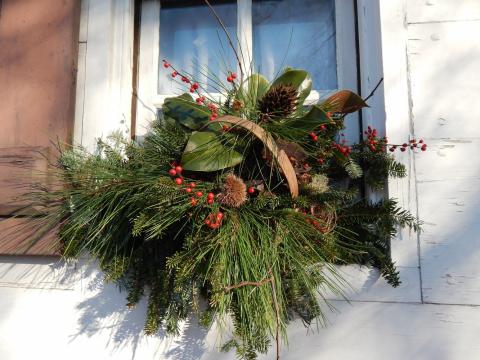Which greens can I collect for making holiday decorations?

Most holiday decorations, such as wreaths, swags and centerpieces, can be created with natural materials gathered from the yard and garden and are easier to make than you might think. As long as you prune with care, you can harvest branches from most evergreens as well as other landscape plants without damaging their appearance. This material will often be fresher than what can be purchased and potentially last much longer.
Evergreen boughs form the backbone of almost all projects. Pine and fir boughs are the most commonly used because they hold up the longest. Hemlock and spruce drop their needles quickly, especially indoors. Take care when harvesting pine and fir because these trees only grow on new growth, not old. That means if you remove the end of a pine bough, new growth will not develop in that spot to replace what was lost. This is especially important to consider when it comes to valuable landscape plants. You can often cut more than enough branches from wild trees but remember to get the landowner’s permission before you harvest. When in doubt, you should be able to purchase some extra material at a florist shop or Christmas tree farm.
Other evergreens can also be harvested like juniper, cypress (Chamaecyparis) and yew, which are not only attractive in arrangements, but will produce new growth on older wood to a certain extent. Conservatively clipping a few boughs won’t hurt the overall look of the plant and may help control size. Skip arborvitae unless you only plan to have it on display for a short time (it tends to discolor rather quickly both indoors and out). Many broadleaf evergreens can also be attractive accents on wreaths and swags and shouldn’t be overlooked. Good candidates for decorating include holly, rhododendron, mountain laurel, boxwood and inkberry.
Beyond greens, other natural materials can enhance arrangements. The red berries of winterberry can be a festive addition, and dried grasses and cones can give decorations a natural look. Colorful dogwood branches and crabapple fruit are often underutilized. There are no hard and fast rules when it comes to natural materials, so have fun experimenting!
It is a good idea to keep all decorative greens out of reach of inquisitive children and pets. All parts of yew, holly, inkberry, winterberry, rhododendron and boxwood are poisonous if consumed. If you are unsure whether a plant is considered non-toxic, check out the list of toxic and non-toxic plants from the ASPCA.
Got questions? The Ask UNH Extension Infoline offers practical help finding answers for your home, yard, and garden questions. Call toll free at 1-877-398-4769, Monday to Friday, 9 a.m. to 2 p.m., or e-mail us at answers@unh.edu.
Related Resource(s)
Do you love learning about stuff like this?
SUBSCRIBE TO Granite State Gardening newsletter
Got questions? The UNH Extension Yard and Garden Infoline offers practical help finding answers for your yard and garden questions.
Call toll free at 1-877-398-4769, Monday to Friday, 9 a.m. to 2 p.m., or fill out webform.
